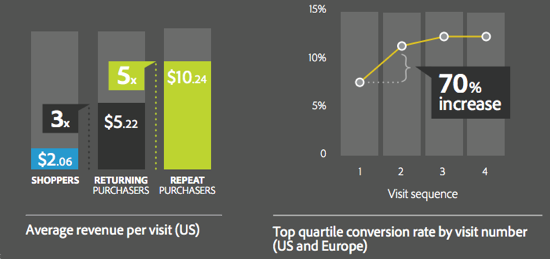There are two main groups in marketing. The acquisition marketing, and relationship marketing folks. Here is a quick definition of each group:
Acquisition Team = Focused on driving anonymous people to known individuals (sign up, purchase, etc)
Relationship Team = Focused on driving known individuals to take action (purchase, repurchase, etc)
It is important to distinguish the two audiences, as marketing moves to an orchestrated individualized experience, we need to be able to create experiences for individuals across all the digital channels based on what data we know about them.
Some individuals are anonymous (we don't have any data on them) and are limited to certain digital channels to communicate to them (for example, email needs permission first but display retargeting does not).
Known individuals come with a greater set of data and opportunities to reach out through other channels (following the same example as above, they have opted-in to email, mobile, etc). Hopefully you also have purchase and behavioral data to now use for better communications to these customers.
As we look to grow our customer base, we need to be smarter about who we attempt to acquire. It's time to optimize the acquisition budget. Optimizing our acquisition efforts to grow the right kind of customers can help grow revenue quickly instead of a one size fits all mentality. This is where the acquisition team can learn from the relationship team.
1. Identify current high value customers based on purchase & engagement data. Who buys often? Engages regularly? Who doesn't?
2. Using your data (first party) what values are in common amongst these audiences? Interests, source, etc?
3. Using third party data, what other attributes bubble up for these groups? Age, demographics, lifestyle, etc?
Now that you have a good snapshot of what makes up a high value customer, you can use this information to be much smarter and strategic with your acquisition dollars. This new data can now be used for retargeting efforts in display to drive awareness from similar non-current customers. You can also use this data for social targeting as well. Use this information to target similar customers on Twitter and Facebook. Don't stop there though, there is more to be done.
There is another critical hand-off that most miss, and thats the period between acquisition target to opted-in customer. Use the information you have been using to acquire these customers / leads to better inform your welcome and nurture programs. Can you take the same data elements and inform your content in your first communication streams to customers? Also, use these communications to fill the gaps in your data to better inform these communications. Are there certain data points you need to help increase conversion? Tactics like progressive profiling, web & click behavioral targeting are all good ways to fill in the missing data points.
Are you doing this already? What kind of results are you seeing? How targeted are you getting with your acquisition efforts?







